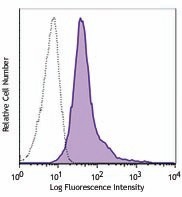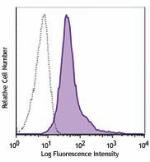- Clone
- TX41 (See other available formats)
- Regulatory Status
- RUO
- Other Names
- CD300a, MAIR-I, LMIR-I, CLM-8, CMRF-35H, IRp60
- Isotype
- Rat IgG2a, λ
- Ave. Rating
- Submit a Review
- Product Citations
- publications

-

MAIR I-transfected cells (ST87) were stained with purified anti-mouse CD300a (clone TX41) (filled histogram) or purified rat IgG2a isotype control (open histogram), followed by anti-rat IgG PE.
| Cat # | Size | Price | Quantity Check Availability | Save | ||
|---|---|---|---|---|---|---|
| 147901 | 100 µg | 216€ | ||||
Select size of product is eligible for a 40% discount! Promotion valid until December 31, 2024. Exclusions apply. To view full promotion terms and conditions or to contact your local BioLegend representative to receive a quote, visit our webpage.
CD300 receptors are a group of type I transmembrane proteins, which belong to the Ig superfamily. In mice, nine members have been reported with different nomenclature systems, such as myeloid-associated Ig-like receptor (MAIR), leukocyte mono-Ig-like receptor (LMIR), DC-derived Ig-like receptor (DIgR), and CMRF-35-like molecule (CLM). The CD300 molecules act as either activating or inhibitory receptors through interactions with adaptor molecules, such as PAD12, DAP10, and FcRγ. CD300a is an inhibitory receptor that is mainly expressed on peripheral eosinophils, mast cells, neutrophils, dendritic cells, macrophages, and some B cells. Cross-linking CD300a by an antibody can induce phosphorylation of tyrosine residues in the cytoplasmic domain, which results in recruitment of phosphatases SHIP, SHP1 and SHP2 and inhibition of cell activation.
Product DetailsProduct Details
- Verified Reactivity
- Mouse
- Antibody Type
- Monoclonal
- Host Species
- Rat
- Immunogen
- MAIR-I transfected
- Formulation
- 0.2 µm filtered in phosphate-buffered solution, pH 7.2, containing no preservative.
- Endotoxin Level
- Less than 0.01 EU/µg of the protein (< 0.001 ng/µg of the protein) as determined by the LAL test.
- Preparation
- The Ultra-LEAF™ (Low Endotoxin, Azide-Free) antibody was purified by affinity chromatography.
- Concentration
- The antibody is bottled at the concentration indicated on the vial, typically between 2 mg/mL and 3 mg/mL. Older lots may have also been bottled at 1 mg/mL. To obtain lot-specific concentration and expiration, please enter the lot number in our Certificate of Analysis online tool.
- Storage & Handling
- The antibody solution should be stored undiluted between 2°C and 8°C. This Ultra-LEAF™ solution contains no preservative; handle under aseptic conditions.
- Application
-
FC - Quality tested
IP, Activ - Reported in the literature, not verified in house - Recommended Usage
-
Each lot of this antibody is quality control tested by immunofluorescent staining with flow cytometric analysis. For flow cytometric staining, the suggested use of this reagent is ≤1.0 µg per million cells in 100 µl volume or 100 µl of whole blood. It is recommended that the reagent be titrated for optimal performance for each application.
- Application Notes
-
Additional reported applications (for relevant formats) include: immunoprecipitation and induction of cytokine production by peritoneal macrophages.
- Application References
-
- Nakahashi-Oda C, et al. 2012. J. Exp. Med. 209:8. (FC, Block)
- RRID
-
AB_2563668 (BioLegend Cat. No. 147901)
Antigen Details
- Structure
- Ig superfamily, three immunoreceptor tyrosine-based inhibitory motifs (ITIMs), one non-canonical ITIM
- Distribution
-
Peripheral eosinophils, mast cells, neutrophils, dendritic cells, macrophages, and some B cells
- Function
- Acts as an inhibitory receptor
- Interaction
- DAP12, DAP10, FcRγ
- Ligand/Receptor
- Phosphatidylserine
- Cell Type
- B cells, Dendritic cells, Eosinophils, Macrophages, Mast cells, Neutrophils
- Biology Area
- Immunology, Innate Immunity
- Molecular Family
- CD Molecules
- Antigen References
-
1. Yotsumoto K, et al. 2003. J. Exp. Med. 198:223.
2. Martinez-Barriocanal A, et al. 2010. J. Biol. Chem. 285:41781.
3. Borrego F. 2013. Blood. 121:1951.
4. Lankry D, et al. 2013. Eur. J. Immunol. 43:2151. - Gene ID
- 217303 View all products for this Gene ID
- UniProt
- View information about CD300a on UniProt.org
Related Pages & Pathways
Pages
Related FAQs
- Do you guarantee that your antibodies are totally pathogen free?
-
BioLegend does not test for pathogens in-house aside from the GoInVivo™ product line. However, upon request, this can be tested on a custom basis with an outside, independent laboratory.
- Does BioLegend test each Ultra-LEAF™ antibody by functional assay?
-
No, BioLegend does not test Ultra-LEAF™ antibodies by functional assays unless otherwise indicated. Due to the possible complexities and variations of uses of biofunctional antibodies in different assays and because of the large product portfolio, BioLegend does not currently perform functional assays as a routine QC for the antibodies. However, we do provide references in which the antibodies were used for functional assays and we do perform QC to verify the specificity and quality of the antibody based on our strict specification criteria.
- Does BioLegend test each Ultra-LEAF™ antibody for potential pathogens?
-
No, BioLegend does not test for pathogens in-house unless otherwise indicated. However, we can recommend an outside vendor to perform this testing as needed.
- Have you tested this Ultra-LEAF™ antibody for in vivo or in vitro applications?
-
We don't test our antibodies for in vivo or in vitro applications unless otherwise indicated. Depending on the product, the TDS may describe literature supporting usage of a particular product for bioassay. It may be best to further consult the literature to find clone specific information.
Other Formats
View All CD300a Reagents Request Custom Conjugation| Description | Clone | Applications |
|---|---|---|
| Ultra-LEAF™ Purified anti-mouse CD300a | TX41 | FC,IP,Activ |
Compare Data Across All Formats
This data display is provided for general comparisons between formats.
Your actual data may vary due to variations in samples, target cells, instruments and their settings, staining conditions, and other factors.
If you need assistance with selecting the best format contact our expert technical support team.
-
Ultra-LEAF™ Purified anti-mouse CD300a

MAIR I-transfected cells (ST87) were stained with purified a...
 Login / Register
Login / Register 









Follow Us